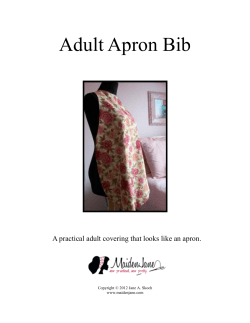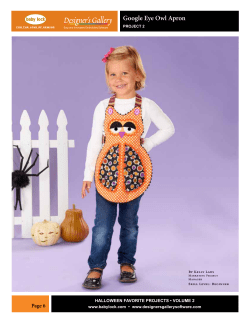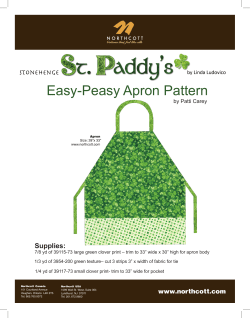
PPE Technical specifications, standards and norms
PPE Technical specifications, standards and norms UNICEF Industry Consultation on Personal Protective Equipment needs in Ebola response Technical specifications, standards and norms Nagwa Hasanin, Shauna Mullally, Ludo Scheerlink We need to protect against: EVD Virus-Infectious liquid Liquid: amount, disease progress 5-10 L of fluid lost daily at a critical stage of their illness. consumed 4.5 L of ORS daily Liquid-tight Blood (RBCs): RBCs 10,000 nm in diameter Resist blood penetration Virus: Ebola: diameter approx. 80 nm, length can be quite variable Tested against Viral penetration other bloodborne virus HIV: 80 ng in diameter 2 Biohazard elements 3 PPE products covered Target protection area PPE component for ETU PPE component for CCC Technical Lead Body Full Body Coverall/ Hood/ Apron Partial Body Nagwa Gown / Hood /Apron Shauna Mucosae Eyes Goggles/ Face shield Goggles/ Face shield Ludo Nose Respirator / mask Respirator / mask Ludo Hands Gloves Gloves Ludo Feets Boots Boots Ludo Mouth Proximities 4 Full Body protection: Coveralls (1) Context of use - Used for Isolation high risk areas within ETU/ Holding Center Short specifications - Disposable, single-use liquid-penetration resistant, biohazard-protective coverall with hood, for use in EVD patient-isolation units suitable for stringent infection prevention and control practices and tested against viral penetration. Protective seams providing barrier equal to fabric Standards - CE 89/686/EEC, Category III: Chemical protective coverall, Type 3B / Type 4B comply with EN14605:2005 +A1:2009 (or equivalent) marketing approval certificate - compliance with the EN 14126:2003 passing infectious agent test according to ISO 16604:2004 standard at minimum exposure pressure of 1.75kPa (class 2) (or equivalent international standard) Full Body protection: Coveralls (2) Context of use - Used for Isolation high risk areas within ETU/ Holding Center Short specifications - Coverall: Disposable, single-use, liquid-penetration resistant, biohazard protective coverall, co-packed with an apron/gown for use in EVD patient-isolation units suitable for infection prevention and control practices. - Apron: Gown designed with sleeves, for front protection with complete closure from the back and wrap around-waist ties. Elasticated cuffs. Shin length and below-Knee height. Both Coverall and Apron are made of fabric that is infective agent tested against viral penetration at minimum 1.75kPa Standards - CE 89/686/EEC, Category III Type 6B comply EN 13034:2005 + A1:2009 (or equivalent)/ / 6PB comply with either EN 13034:2005 + A1:2009 or EN14605:2005 +A1:2009 (or equivalent) marketing approval certificate - Confirmation of compliance with the EN 14126:2003 passing infectious agent test according to ISO 16604:2004 standard at minimum exposure pressure of 1.75kPa (class 2) (or equivalent international standard) Full Body protection: Specific issues: Limited global capacity for immediate supply limited supplier base Relatively Long lead-time (in terms of emergency response) Partial Body protection: Hood Context of use - Used for Isolation high risk areas within ETU/ Holding Center / CCC Short specifications - Disposable, single-use, liquid-penetration resistant, biohazard-protective Hood with or without surgical mask Type IIR, for use in EVD patient-isolation units suitable for infection prevention and control practices and tested against microbial penetration. Cape hood covering full neck and parts of shoulders Standards - CE 89/686/EEC marketing approval certificate - Mask: conform to EN 14683:2005 for type IIR mask (or equivalent standard) - Compliance with the EN 14126:2003 passing infectious agent test according to ISO 16604:2004 standard at minimum exposure pressure of 1.75kPa (class 2) (or equivalent international standard) (Preferred) Partial Body protection: Protective Gown/Apron Context of use - Used for Isolation high risk areas within ETU/ Holding Center / CCC Short specifications - Disposable, single-use, liquid-penetration resistant, biohazard-partial-body protective gown /apron with sleeves for use in EVD patient-isolation units and CCC suitable for infection prevention and control practices and tested against viral penetration. Standards - CE 89/686/EEC, Category III Type 3PB or 4PB or 6PB comply with EN14605 :2005+A1:2009 or EN 13034:2005 + A1:2009 (or equivalent) marketing approval certificate - Comply with EN 14126:2003 passing infectious agent test according to ISO 16604:2004 standard at minimum exposure pressure of 1.75kPa (class 2) (or equivalent international standard) Partial body protection: Surgical gowns (1) AAMI Level 4, fully reinforced Context of use - Higher risk areas such as CCCs, clinical care – wet areas Short specifications - Surgical gown with long sleeves and a waist tie that binds at side or back - Non-woven material (SMS, SMMS, etc.), reinforced material throughout gown that passes ASTM F1671 - size approx. 150 cm (W) x 130 cm (L) - Single use, disposable Standards - Meets requirements for ANSI/AAMI PB70 (US) classification Level 4 Only AAMI Level 4 gowns pass test for resistance to penetration by a blood-borne viral pathogen (ASTM F1671) - May also have CE 93/42: EN 13795 (EU) - Or equivalent Partial body protection: Surgical gowns (2) Standard/high performance EN 13795 Context of use - Lower risk areas such as CCCs, clinical care - dry area, other lower risk areas in HC facilities Short specifications - Surgical gown with long sleeves and a waist tie that binds at side or back - Non-woven material (SMS, SMMS, etc.), reinforced in critical areas if HP gown - size approx. 150 cm (W) x 130 cm (L) - Single use, disposable Standards - CE 93/42: EN 13795 standard performance (SP) or high performance (HP) - Or equivalent Partial body protection: Surgical gowns Specific issues: PPE for Ebola is not the intended use of the product Supply challenges - Limited global capacity for immediate supply - Relatively long lead-time for quantities requested Tests and standards not equivalent across stringent national regulatory authorities EN 13795 (EU) does not include test for resistance to penetration by a bloodborne viral pathogen Only AAMI Level 4 gowns pass test for resistance to penetration by a bloodborne viral pathogen (ASTM F1671) in the gown’s critical zones Product limitations - Definition of ‘critical area’ not as relevant, not adequate for high-risk - Sleeves require taping - Sterility – not necessary Partial body protection: Aprons (disposable) Context - ETUs and CCCs over full or partial body protection Short specifications - Single use, sleeveless apron with adjustable back- and neck-band - Seamless, liquid proof and stain resistant - Material: durable environmentally friendly plastic, polyethylene (PE) - Size, approx.: 85 x 130 cm (w x l) - Thickness: approx. 50 µ Standards - None yet identified Specific issues - Size and thickness - Sourcing Partial body protection: Aprons (reusable) Context - Heavy duty (cleaning activities) Short specifications - Reusable sleeveless protective apron with adjustable back- and neck-band - Seamless liquid proof and stain resistant - Material: durable environmentally friendly plastic - Size, approx.: 120 x 145 cm (w x l) - Thickness, approx.: 300 µ Standards - None yet identified Specific issues - Size, sourcing Thank you UNICEF Industry Consultation on Personal Protective Equipment needs in Ebola response Technical specifications, standards and norms
© Copyright 2025









